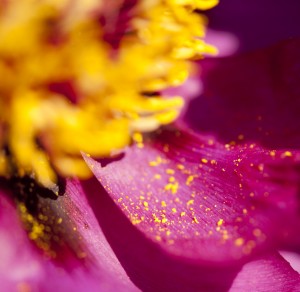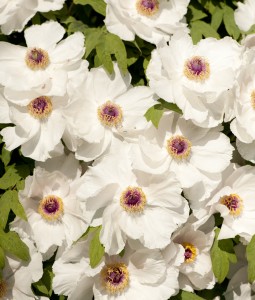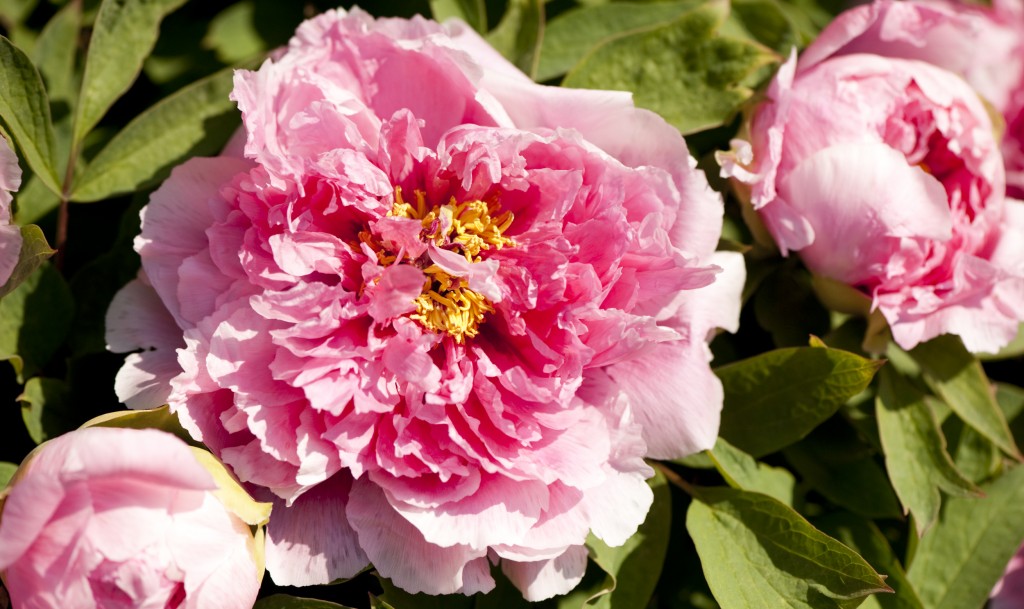Tree Peonies: Better than Jade
Posted in Around the Garden on April 20 2012, by Matt Newman
 Moss covered paths between scarlet peonies,
Moss covered paths between scarlet peonies,
Pale jade mountains fill your rustic windows.
I envy you, drunk with flowers;
Butterflies swirling in your dreams.
— Qian Qi, Tang Dynasty
In the words of poet Billy Collins, the lyricists of Imperial China had “nothing up their ample sleeves” as they scribbled down the world around them. There’s a candid linearity to the early Chinese wordsmiths. Never dawdling in the roundabout of ten dollar adjectives or subtlety, they explain what they see with directness and clarity, and in doing so pull the reader into a rich history of images.
Today, standing on the hill overlooking the Peggy Rockefeller Rose Garden among prim rows of rounded tree peony shrubs, I found the same honest verse in each flower. It’s right there in the names. From time to time I would crouch to part the branches in an effort to see the cultivar titles on the small signs below each plant. Behind the leaves I discovered shaped words, often as straightforward as dynastic verse, at other times more like flash fiction–short stories in a staccato of concrete nouns. Our tree peonies are a lyrical bunch, blooming as they are in this early spring.

Names like ‘Colored Painting’ and ‘White Phoenix’ are similar to what you find tacked onto most modern plant cultivars. They’re simple and effective. But there are so many other plants in this collection, long present in the horticultural register, which take the wordsmith’s route. ‘Lotus that Shines in the Sun,’ reads one sign, describing the effulgent plant above it with broad, ivory petals on each of its saucer-like flowers. Another, ‘Plum Blossom Facing the Snow Storm,’ speaks of character with an artist’s stroke. And then I happened upon what might well be the pageant winner: ‘Coiled Dragon in the Mist Grasping the Purple Pearl.’
Verbose, yes, but you’re not left wondering what you’re looking at.
The wording of each tree peony’s cultivar name is fitting for Poetry Month. These hardy and long-lived plants (there are some specimens in their native China estimated to be over 200 years old) owe their monikers to a history spent in cultivation throughout Chinese and Japanese gardens. Known as mudan in the former, it is said that the wide, bright flowers have been prized not only for their ornamental value, but for medicinal uses in a horticultural legacy lasting over 3,000 years. The hallowed regard for this vibrant flowering shrub–it was a favorite of Chinese emperors throughout the many ruling dynasties–shows not only its many ostentatious names, but the fantastical tales behind them as well. ‘Qing Long Wo Mo Chi’ is the perfect example.
Translating to “Green Dragon Lying in an Ink Pool,” this peony’s story is rich in the vein of the Prometheus myth, albeit of a more cheerful bent. During a year of unforgiving drought, a small dragon found sympathy for the plants dying around him. Seeking to relieve their pain, he risked his own life in venturing to Yao Tai (home of the supreme being) to steal water. The goddess of the tree peonies, seeing the dragon’s selflessness, then offered protection from the elder god’s wrath by hiding the hero in a pool of ink. The name came to describe a deep purple, almost black tree peony that now serves as a traditional symbol of dedication.

We like to think the many historic cultivars we have here in our Tree Peony Collection are backed by the same elements of myth and legend. ‘Better than Jade with Triple Magic’ can’t help but have a fanciful yarn behind it.
But while ancient history is all well and good, what about our collection as it exists in the modern day? It’s said that when the wife of eccentric painter Salvador Dalí first admired the NYBG‘s peonies alongside Elizabeth Taylor, her husband set out to fill his beloved’s bedroom with the enormous flowers. Since then our display has only grown; would the mustachio’d surrealist have stocked the entire house had his wife swooned over the dozens of plush peony shrubs as they are today?
With warmth finally working its way into the early spring sunlight, the tree peonies–which usually peek out from their gargantuan flower buds at the beginning of May–are making a brash appearance in the midst of April. So when you set out to visit the Orchid Show this weekend (or come along for our Earth Day festivities on Sunday), keep your eyes open for signs pointing toward the Peggy Rockefeller Rose Garden. Follow the sloping paths to the larger-than-life blossoms perched just above the gate to experience a beauty steeped in history.


Great read, lots of helpful information, thank you very much!